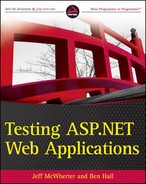1.1. The History of Testing Tools
Tools for testing have been around for as long as developers have been writing code. In the early years of software development, however, there wasn't a clear distinction between testing and debugging. At the time, this model worked. Some argue that this model worked because the system was closed; most companies who needed software had the developers on staff to create and maintain the systems. Computer systems were not widespread, even though developers worked very closely with customers to deliver exactly what was required. In the years between 1970 and 1995, computer systems started becoming more popular, and the relationships between developers and customers became distant, often placing several layers of management between them.
What is the difference between debugging and testing you might ask? Testing is the process of finding defects in the software. A defect could be a missing feature, a feature that does not perform adequately, or a feature that is broken. Debugging is the process of first tracking down a bug in the software and then fixing it.
Many of the tools developers used for testing in the early days were internal tools developed specifically for a particular project and oftentimes not reused. Developers began to see a need to create reusable tools that included the patterns they learned early on. Testing methodologies evolved and tools started to become standardized, due to this realization. In recent years, testing methodologies have become their own, very strict computer science discipline.
During the past 12 years, many tools have been developed to help make testing easier. However, it's essential to learn about the past and the tools we had previously before diving into the set of tools we have now. It's important to notice that the tools tend to evolve as the process evolves.
The term "debugging" was made popular by Admiral Grace Murray Hopper, a woman who was working on a Mark II computer at Harvard University in August 1945. When her colleagues discovered a moth stuck in a relay, and realized it was causing issues with the system, she made the comment that they were "debugging the system."
1.1.1. The sUnit Testing Framework
It is said that imitation is the sincerest form of flattery; that said, most modern unit testing frames are derived from the principals set forth in the sUnit testing framework primary developed by Kent Beck in 1998. Below are just a small number of frameworks which have built upon Beck's original concept.
sUnit. Created by Kent Beck for Small Talk, sUnit has become known as the "mother of testing frameworks." Many popular unit testing frameworks such as jUnit and nUnit are ports of sUnit. The key concepts of the sUnit testing framework were originally published in Chapter 30 of Kent Beck's Guide to Better Smalltalk (Cambridge University Press, 1998).
jUnit. A port of sUnit for Java created by Kent Beck and Erich Gamma in late 1998. jUnit helped bring automated unit testing into the main stream.
nUnit. In late 2000, all the great things about jUnit were ported to .NET allowing C# developers to write jUnit style unit tests against their C# code.
qUnit. This is the unit test running for the jQuery Framework. In May 2008, qUnit was promoted to a top-level application in the jQuery project. qUnit allows web developers to run unit tests on JavaScript.
WCAT. First included in the IIS 4 resource kit in 1998, the Web Capacity Analysis Tool (WCAT) is a freely distributed command-line tool that allows a server to be configured with agents to perform load/stress testing on websites.
Web Application Stress Tool. In 1999, Microsoft released a free tool to create GUI browser stress tests. This tool recorded a browser session and scripted the actions into a Visual Basic 6 script that could be modified. Because the tool generated scripts that could be modified, many web developers used the tool not only for stress testing but modified the scripts for user interface functional testing.
Microsoft Application Center Test. Included in Visual Studio 2001 Enterprise Edition, Microsoft ACT improved upon the Web Application Stress tool. Microsoft ACT provided a schema in which the tests could be distributed among agents for large-scale load testing.
Framework for Integrated Test (FIT). Created by Ward Cunningham in 2002, FIT is a tool for automated customer tests. Examples of how the software should perform are provided by the customer, and automated Test fixtures are created by the developer. The goal of FIT is to help integrate the work of developers, customers, tests, and analysts.
Fitnesse. Ported to .NET in 2006 by David Chelimsky and Mike Stockdale, Fitnesse combines a web server, Wiki, and the FIT software acceptance testing framework together. This provides an acceptance testing framework which allows users to define input that can be interpreted by a Test fixture allowing for non-technical users to write tests.
Watir. In May 2002, the Web Application Testing in Ruby Watir (pronounced "Water"), a library to automate browser acceptance tests in Ruby, is released.
Selenium. Selenium provides a suite of tools for automated user interface testing of web applications. In 2004, Jason Huggins of Thoughtworks created the core "JavaScriptTestRunner" mode for automation testing of a time and expense system.
WatiN. In May 2006, Watir, the popular browser acceptance testing framework, is ported to .NET as the WatiN (pronounced "Watt in") project.
Visual Studio 2005 Test Edition. In 2005, Microsoft released a version of Visual Studio that included a new unit testing framework created by Microsoft called MS Test. Along with this new unit testing framework, what was known previously as Microsoft Application Center Test (Microsoft ACT) was integrated into this version as Web Unit Tests and Web Load Tests.
Visual Studio 2008 Professional. In 2008, the professional version of Visual Studio 2008 included MSTest.
